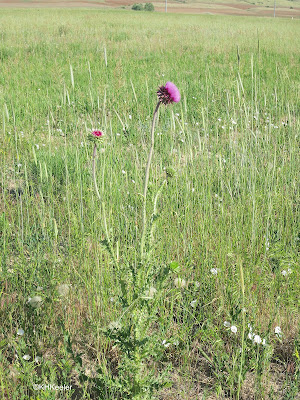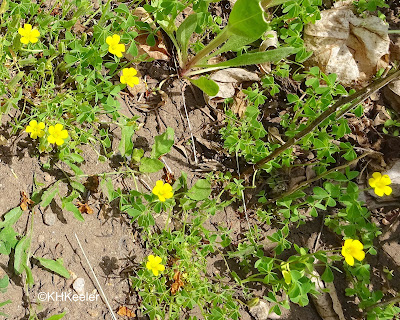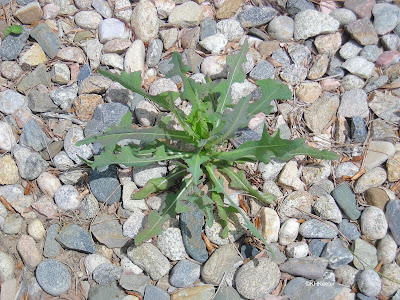Facebook gardening groups post pictures of plants found in their yards and ask "Is this a plant or a weed?" Botanically that is a terrible statement because all weeds are plants, though not all plants are weeds. But what the writer meant was, "Is this a desirable or undesirable plant?"
We can identify the plant, and if the property owner didn't plant it, then it will likely be called a weed.
But that is so limited! I'd like at least a third category.
We are surrounded by plants someone spent time and money to plant and maintain. I'll call these "planted." Most of the those plants--vegetables, fruits, lawn grass, ornamentals--are highly domesticated. They have been heavily modified by centuries of being grown by humans. They are also likely to be from Eurasia.
 |
| Rose |
 |
| musk thistle, nodding thistle, Carduus nutans |
But if you scored the plants in the ordinary yard into "planted" and "weeds." there will be some that don't fit. I'm arguing that two aren't enough categories. Suppose we call a plant a weed if it appears in a regional "weed list." Weed lists are rarely 200 species long, so many plants are neither "planted" nor "weeds." I'll call them "wild plants" because they appeared in my yard on their own. Wild in "wildflower" has connotations of showy, attractive flowers. My "wild plants" may not be attractive to me; they are wild, not sculpted by humans.
 |
| This is a wild euphorbia, probably Euphorbia dentata |
Who are these "wild plants?"
Here's a list from my yard: creeping hollygrape (Berberis repens), lamb's quarters (Chenopodium album and a related species), sandmat (Chamaesyce sp.), catnip (Nepeta cataria), pigweed (Amaranthus retroflexus), purslane (Portulaca oleracea), wood sorrel (Oxalis), wild lettuce (Lactuca sp.), black medic (Medicago lupulina), three small oak trees (Quercus), a dozen maples (Acer), several small junipers (Juniperus), chokecherries (Prunus), ground cherry (Physalis longifolia), a spurge (Euphorbia sp.).
 |
| longleaf ground cherry, Physalis longifolia |
I also find field bindweed (Convolvulus arvensis), dandelions (Taraxacum officinale), Canada thistle (Cirsium arvense, aka creeping thistle), crabgrass (Digitaria), and green foxtail (Setaria viridis): these are weeds.
Also at large in my yard are plants I grew at some time in the past and have self-seeded: clary sage (Salvia sclarea), salad burnet (Sanguisorba minor), carrots (Daucus carota), and weld (Reseda luteola), for example.
The wild plants live in my neighborhood and my yard, getting around on their own. Some are native to my area, some have migrated here from far away. In my yard, they do no particular harm and provide food for a variety of animals, from bees and butterflies to songbirds.
I let the hollygrape stay as a native foundation plant, though it is so prolific I weed out a lot of it. I left the lambsquarters in the corners of the yard I don't usually get to because it is edible and every so often I gather it as a vegetable. Purslane is in the same category. The ground cherry is probably edible, but I haven't ever done anything with it.
 |
| purslane, Portulaca oleracea |
Sandmat though, makes the problem clear. It doesn't have a use in my yard, but it is unoffensive. If it isn't making my pathway look untidy, why should I weed it out? Plants are alive, they climb toward the sun, open flowers, develop seeds. It seems more nourishing for both the plant and me that I see it and say "how are you growing today, sandmat?" rather than "Oh! No! Sandmat! I'll rip you out!"
 |
| sandmat, Chamaesyce species and two purslanes (Portulaca) both very small |
Of course, a yard of monoculture patches has no place for wild plants and so they must be weeds. But I define what is a weed in my yard, so I'm reserving the term weed for plants I really can't live with, and that's a short list.
 |
| wood sorrel, Oxalis |
The term probably won't catch on, but calling them "wild plants" says what I want to say, that my yard is wild(plant)life habitat.
Comments and corrections welcome.
More at awanderingbotanist.com
Join me on Facebook: https://www.facebook.com/AWanderingBotanist

I agree! Plenty of plants appear on their own in my yard. If they aren't "aggressive" (my term) I usually leave them, whether native or not. I just finished pulling undesirables (kochia, salsola) and leaving lambstongue, purslane, and several amaranths that I like :)
ReplyDeleteI have areas full so full of introduced plants that there are zero native species. I look to see what faunal relationships exist with those plants, and consider what native plant community lived there once and what the individual plants were within it. I look up the faunal relationships of the plants in both groups and then make my decision. One thing I think about in addition to the above, and watch carefully for, is plants that are not native that monopolize the time of native pollinators, because this is fundamental to how native plants survive via reproduction. If it is extreme (such as the invasive sweet clover (Melilotus alba) or my (once) beloved globe thistle (Echinops ritro), then I remove the invasive out of consideration to all my neighbors, both human, animal and plant, or greatly reduce its presence in the case of the globe thistle. We have strong emotional attachments to plants, but the animals that are obligate to certain plants cannot survive without them, and the plants cannot survive if they are not being served by animals that pollinate them and move their seeds. The whole system is delightfully intricate and I am interested in both learning more and facilitating evolved relationships, finding startling and exciting discoveries, such as the appearance of the two leafed toothwort (Cardamine diphylla) in a spot near the brook where I had been weeding invasive moneywort (Lysimachia nummularia) introduced by the previous owners' hanging basket for years, because it totally dominates the ground if left untended..."one more year" I mutter to myself...but it does keep spreading and popping up in new places. Some plants are un-killable once introduced, and this is one. A small victory.
ReplyDelete